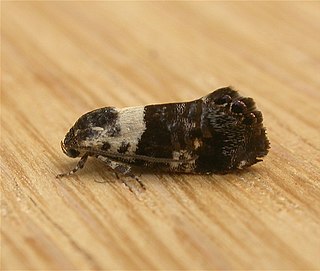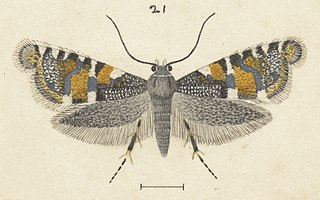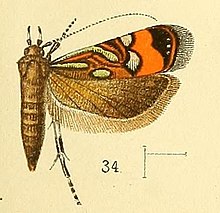
Curetis bulis, the bright sunbeam, is a species of butterfly belonging to the lycaenid family. It is found in Asia.

The Indian fritillary is a species of butterfly of the nymphalid or brush-footed family. It is usually found from south and southeast Asia to Australia.

Eupselia aristonica is a species of moth of the family Depressariidae. It is found in Australia, where it has been recorded from New South Wales, the Australian Capital Territory, Victoria and Tasmania.

Eupselia satrapella is a species of moth of the family Depressariidae. It is found in Australia, where it has been recorded from Queensland, New South Wales and the Australian Capital Territory.

Grammodes stolida, the geometrician, is a moth of the family Erebidae. The species was first described by Johan Christian Fabricius in 1775. It is found in Africa, southern Europe, most of Asia and Australia. It migrates to central and northern Europe as far north as England, Denmark and Finland.

Glyphipterix equitella is a moth of the family Glyphipterigidae. It is found from Fennoscandia to the Iberian Peninsula, Sardinia, Sicily and Crete and from Ireland to Romania.

Glyphipterix euastera is a species of sedge moth in the genus Glyphipterix. It is endemic to New Zealand. This species is classified as "At Risk, Naturally Uncommon" by the Department of Conservation.

Sanguinograptis albardana is a species of moth of the family Tortricidae. It is found in the Republic of Congo, the Democratic Republic of Congo, Equatorial Guinea, Guinea and Gambia.
Dichomeris doxarcha is a moth in the family Gelechiidae. It was described by Edward Meyrick in 1916. It is found in Myanmar.
Dichomeris uranopis is a moth in the family Gelechiidae. It was described by Edward Meyrick in 1894. It is found in Myanmar.
Helcystogramma scintillula is a moth in the family Gelechiidae. It was described by Walsingham in 1911. It is found in Mexico (Tabasco).

Aspades hutchinsonella is a species of moth in the family Gelechiidae. It was described by Walsingham in 1891. It is found in Namibia, South Africa and Zimbabwe.
Pseudotelphusa belangerella is a moth of the family Gelechiidae. It is found in North America, where it has been recorded from Alberta, Maine and Kentucky.
Compsolechia suffectella is a moth of the family Gelechiidae. It was described by Francis Walker in 1864. It is found in Mexico, Panama, Colombia and the Brazilian states of Amazonas and Espírito Santo.
Tricyanaula aurantiaca is a moth of the family Gelechiidae. It was described by Walsingham in 1887. It is found in Sri Lanka.
Thiotricha pancratiastis is a moth of the family Gelechiidae. It was described by Edward Meyrick in 1921. It is found in Japan and Assam, India.
Thiotricha godmani is a moth belonging to the family Gelechiidae. It was first described by Thomas de Grey in 1892. This species is primarily found in the West Indies.
Idiocrates is a monotypic moth genus in the family Depressariidae. Its only species, Idiocrates balanitis, is found in Bolivia. Both the genus and species were first described by Edward Meyrick in 1909.
Hypercallia subreticulata is a moth in the family Depressariidae. It was described by Lord Walsingham in 1881. It is found in South Africa.
Eupselia theorella is a moth in the family Depressariidae. It was described by Edward Meyrick in 1880. It is found in Australia, where it has been recorded from New South Wales.









